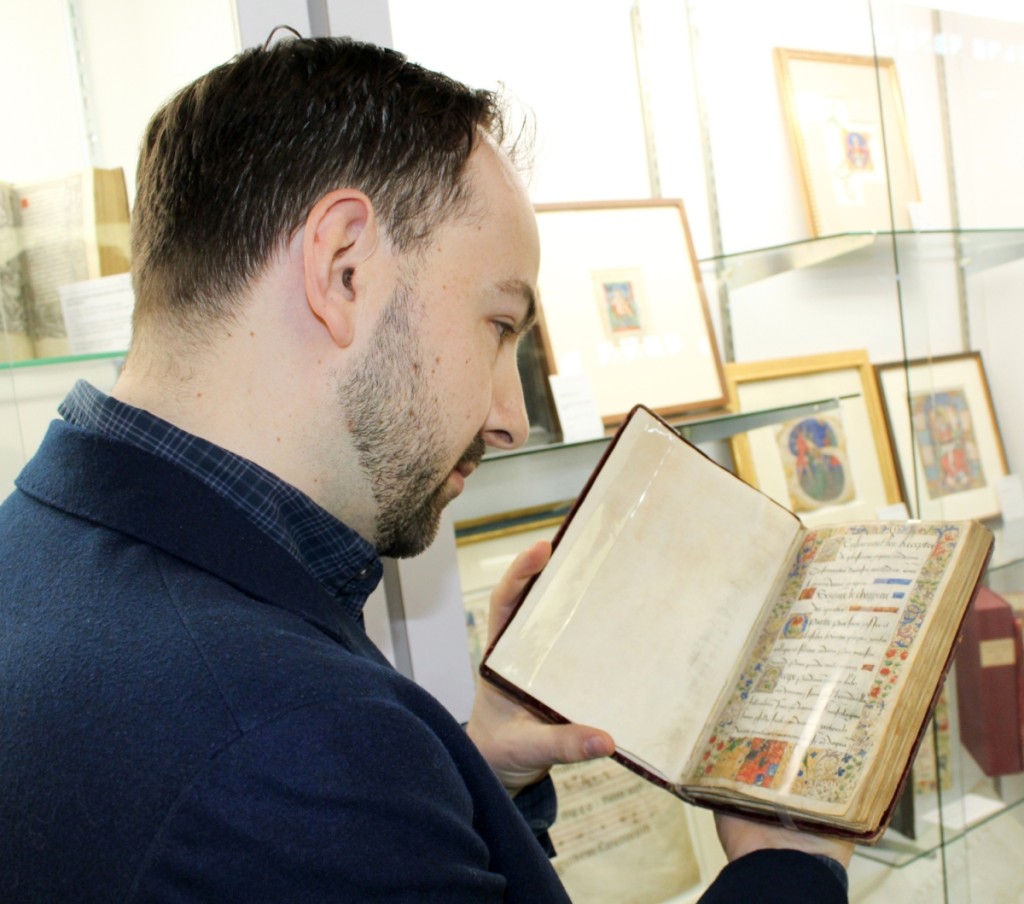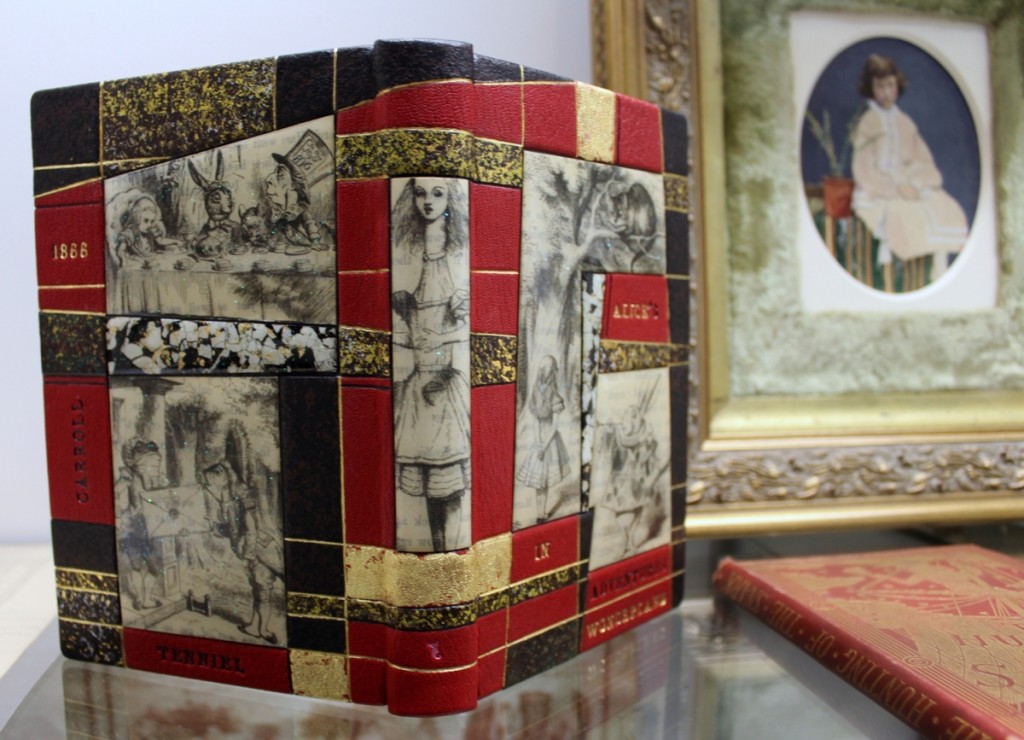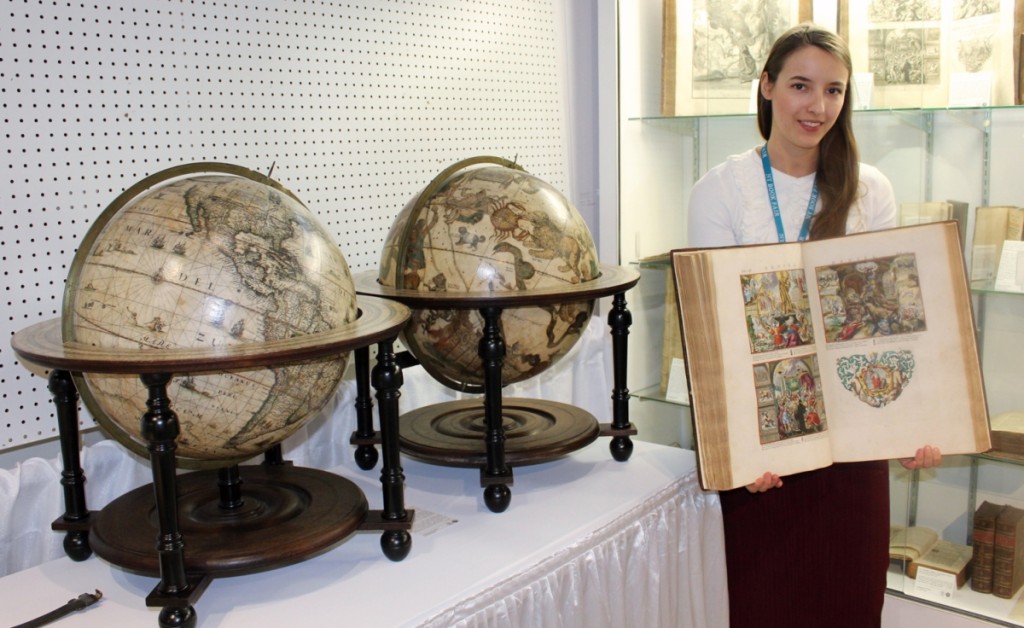
Matt Westerby, archivist and specialist at Les Enluminures, examines an illuminated manuscript comprising a collection of medical recipes and health regimens for the king and court, circa 1515–25. It was bound in a contemporary red velvet binding over wooden boards.
Review and Photos by W.A. Demers
NEW YORK CITY -“Pinnacle” is one of those thankfully rarely used sobriquets to denote a peak experience. It is not misused when it comes to the New York International Antiquarian Book Fair, sponsored each year in Manhattan by the Antiquarian Booksellers’ Association of America and the International League of Antiquarian Booksellers. It is simply the finest book fair that the world has to offer, attracting more than 200 exhibitors from across the United States and international locales to the Park Avenue Armory to offer their best examples of rare books, manuscripts, ephemera, autographs, maps, art and photography.
The show, managed by Sanford L. Smith and Associates, is the anchor for Rare Book Week, opening with a preview on March 8 and up for three days, closing on this year on March 11. During those three and half days, an amazing amount of high-quality, scarce and fine bibliographic material is laid out in a literary and historical smorgasbord for collectors, dealers, scholars and institutions.
“It was the best book fair that I have had in my 30 years managing the show,” said Sandy Smith, who noted that it was also the highest attendance that they have ever had. “It was up in attendance and sales, and the armory was packed to the extent that we had to add a second coatroom. You know it’s a great show when dealers are busy up until 4:30 on Sunday afternoon.”
Among the slew of collectors, librarians, scholars and museum representatives streaming into the armory at the preview were about 18-20 West Point cadets, all dressed in uniform, who were apparently on a field trip into the city as part of a book course they were taking at the academy. It was a heartening sight to Smith, who said he delighted in their addressing him as “sir.”
Show regular and front-of-the-hall exhibitor Donald Heald concurred with Smith’s assessment of this year’s event. “The show was very successful, with record-setting attendance,” said Heald. Specializing in illustrated works from the Eighteenth and Nineteenth Centuries, including Americana, natural sciences, travel and voyages, photography and others, he filled his showcases with rare treasures like John Abbot’s earliest illustrated monograph devoted to the butterflies and moths of North America, London, 1797; an 1814 first edition of a history of the Lewis and Clark expedition in North America, complete with large, folding map, and a complete portfolio of Thomas Moran’s color plates of landscape scenery of the American West.
This year, Antiquariaat De Roo was exhibiting for the second time, J.B. “Bart” de Roo and his sister-in-law Nancy de Bruin showing a selection of the company’s finest books and related items. Established 2004, the firm specializes in bibles, theology, history, church history and hand colored works.
One of their highlights was a pair of rare Hondius globes published by Johannes Janssonius (1588-1664) at Amsterdam in 1623 and 1648. The globes were prepared by Jodocus Hondius the younger (1597-1651), and included both a terrestrial and celestial globe with a diameter of 17 inches each.
De Roo also brought a miniature book, which, until 1897, held the record for being the smallest printed book in the world. The little book is in Dutch and titled Bloem-Hofje, which can be translated as “Little Flower Garden.” It contains an anthology of Christian phrases by C. van Lange. The binding measures .51 by .35 by .20 inches. Despite its size, the work is completely typeset, the text printed on double spreads on one side of the paper only and then stuck together to give the impression of normal leaves. Benedikt Smidt, who printed/published the work in 1674, had just moved to Amsterdam in 1673 and probably produced it as a showpiece to demonstrate his technical abilities. He succeeded in doing so and produced this tiny but impressive masterpiece that held the record for the smallest printed book for more than 200 years.
For visitors interested in the Reformation, there was a first edition of one of Martin Luther’s (1483-1546) polemical works titled Von der winckelmesse und Pfaffen Weihe, published in 1533 by Nickel Schirlentz Wittenberg. It contains one of Luther’s fiercest attacks on the Catholic church, especially on the subject of the Mass.
Asked about the double colons employed in her company’s name, Franklin Gilliam : : Rare Books : :, Charlottesville, Va., dealer Mary Gilliam explained that early on when her late husband was seeking a logo design, he simply used the symbol on the then ubiquitous typewriter. “I have been doing this show for about 20 years and since the new dates in March, the crowds have become larger and are more engaged with the material. Sales have also been brisk for most dealers. The armory is a wonderful location for the show – the perfect venue,” she said. Among the highlights Gilliam brought to the show were a 1771-72 printing of Virginia laws revealing a rare example of colonial cooperation between Maryland and Virginia in maintaining a lighthouse on Cape Henry; a self-portrait of Sir William Rothenstein in charcoal and white chalk; a gouache and watercolor by Ethel Bennett Schiffer, “Kneeling Little Girl with Frog,” and a collection of 21 watercolor drawings in an 1887 travel journal featuring the low countries and Heligoland.
In the rare and antiquarian book business for more than 40 years and drawing on a family avocation that began in 1876, David Brass said the collecting category is in his blood. The Calabasas, Calif., dealer had many excellent volumes on display, including a rare Cosway binding by Riviere featuring ten oval and round miniatures by Sir Edwin Landseer, RA, well-known for his paintings of animals, particularly horses, dogs and stags.
New Haven, Conn., book dealer William Reese has since 1975 been an international source for collectors of rare books and manuscripts with a burgeoning cataloged inventory that exceeds 40,000 and a general inventory of more than 65,000 items. On view here, of course, was a just select tip of the iceberg, and emphasizing the firm’s leading position in the fields of Americana and world travel spanning the Eighteenth to Twenty-First Centuries was an exceptional plate book on Mayan monuments, Views of Ancient Monuments in Central America, Chiapas and Yucatan, by Frederick Catherwood, published in London in 1844.

In a spectacular art binding by Robert Wu, this specially commissioned first edition, second issue of the 1866 D. Appleton & Company edition of Lewis Carrol’s Alice in Wonderland was a choice item in Justin G. Schiller’s booth.
There was so much to see at the booth of London dealer Peter Harrington – a signed document by Abraham Lincoln, a second folio of Shakespeare’s plays from 1632, a first edition of The Great Gatsby by F. Scott Fitzgerald, a rare first edition of Das Kapital by Karl Marx, a first edition of The Federalist essays by Alexander Hamilton and signed photographs of Winston Churchill, Margaret Thatcher and Ronald Reagan for starters. Pom Harrington, the firm’s owner, said that he had brought more than 120 rare books, manuscripts and photographs specially selected to be of interest to visitors to the fair. One example that he personally thought most interesting was a first edition, first impression of Kenneth Grahame’s The Wind in the Willows, with a rare first issue jacket and a frontispiece by Graham Robertson, London: Methuen & Co. Ltd, 1908. “Look at the price on the jacket,” he said. “Six shillings!” More than 100 years later, today’s price for the book was in excess of $60,000.
“This year’s fair was fantastic,” reported Andrew Langston of Bauman Rare Books. “Turnout was phenomenal, and we had the pleasure of showcasing some exceptional items – most notably, a book from Thomas Jefferson’s library: The Laws of the United States, containing major legislation related to the Louisiana Purchase and marked by Jefferson’s own annotations and marginalia.”
“The fair was busy with a very good and engaged crowd. We sold well,” said Daniel Crouch Rare Books partner Nick Trimming. Among the firm’s main pieces was John Cary’s first map of the United States, issued under his own imprint, and one of the first maps in English to name the United States. Published in August 1763, it was titled An accurate Map of the United States of America with Part of the Surrounding Provinces agreeable to the Treaty of Peace of 1783.
Said Laura Light of Les Enluminures, “In general, it was a very successful fair; it seemed very well-attended – it always is, but a number of dealers commented on how busy it was. Great to see so many book lovers.”
“The show was very well-attended and sales were brisk all week,” agreed Scott DeWolfe of DeWolfe and Wood, Alfred, Maine. “Sunday the aisles were very crowded and even in the last half hour of the show we had two strong sales, and several of my neighbors also did well during the waning hours of the fair. We sold to dealers, collectors, library curators and the general public.” One of DeWolfe’s sales was to a library, which purchased Narrative and Confessions of Lucretia P. (Patty) Cannon… New York: 1842, an account of the leader of a racially mixed gang that used various methods to kidnap free African Americans in Delaware and Maryland and sell them South to the slave trade. She was eventually convicted of murdering several people and died in prison before she was scheduled to hang.
Just before the preview opened, Seth Kaller, White Plains, N.Y., was still putting the finishing touches on his stand featuring select pieces of a larger collection of rare Alexander Hamilton documents and George Washington’s draft of his first inaugural address comprising three leaves – six pages – and two fragments. Only 13 leaves are known to survive, seven are already in institutions and three in separate private collections.
The show will be back for its 59th edition March 7-10, 2019. For information, 212-777-5218 or www.nybookfair.com.











































